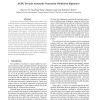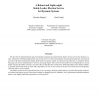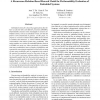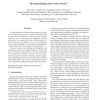DSN
2008
IEEE
15 years 5 months ago
2008
IEEE
An important yet largely uncharted problem in malware defense is how to automate generation of infection signatures for detecting compromised systems, i.e., signatures that charac...
DSN
2008
IEEE
15 years 5 months ago
2008
IEEE
This paper proposes a formally well-rooted and extensible framework for dependability evaluation: Arcade (architectural dependability evaluation). It has been designed to combine ...
DSN
2008
IEEE
15 years 5 months ago
2008
IEEE
We describe the implementation and experimental evaluation of a fault-tolerant leader election service for dynamic systems. Intuitively, distributed applications can use this serv...
DSN
2008
IEEE
15 years 5 months ago
2008
IEEE
Unlike other diversity-based approaches, N-variant systems thwart attacks without requiring secrets. Instead, they use redundancy (to require an attacker to simultaneously comprom...
DSN
2008
IEEE
15 years 5 months ago
2008
IEEE
Temporal locality in workloads creates conditions in which a server, in order to remain available, should quickly process bursts of requests with large service requirements. In th...
DSN
2008
IEEE
15 years 5 months ago
2008
IEEE
Embedded systems for closed-loop applications often behave as discrete-time semi-Markov processes (DTSMPs). Performability measures most meaningful to iterative embedded systems, ...
DSN
2008
IEEE
15 years 5 months ago
2008
IEEE
Existing Byzantine-resilient replication protocols satisfy two standard correctness criteria, safety and liveness, in the presence of Byzantine faults. In practice, however, fault...
DSN
2008
IEEE
15 years 5 months ago
2008
IEEE
Bug tracking systems are important tools that guide the maintenance activities of software developers. The utility of these systems is hampered by an excessive number of duplicate...
DSN
2008
IEEE
15 years 5 months ago
2008
IEEE
This research investigates the automation of security assessment of the static and dynamic properties of cyberinfrastructures, with emphasis on the electrical power grid. We descr...
DSN
2008
IEEE
15 years 5 months ago
2008
IEEE
In future large-scale multi-core microprocessors, hard errors and process variations will create dynamic heterogeneity, causing performance and power characteristics to differ amo...




